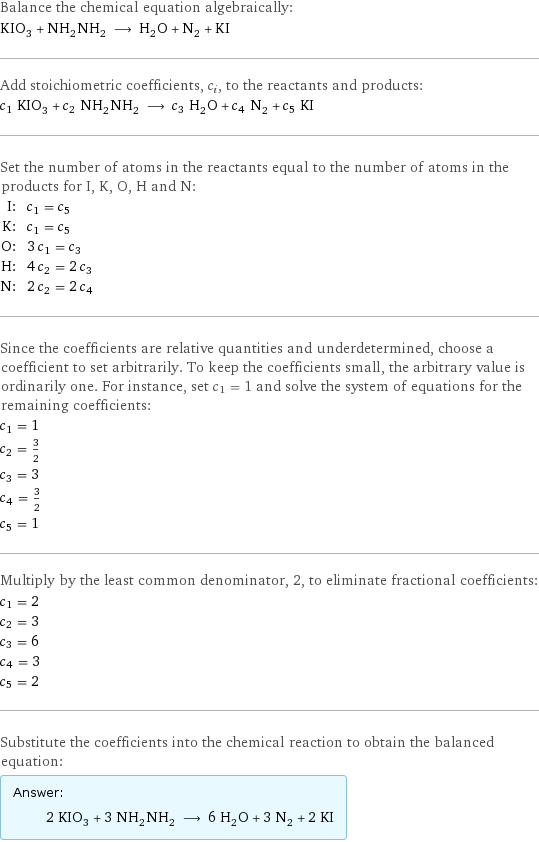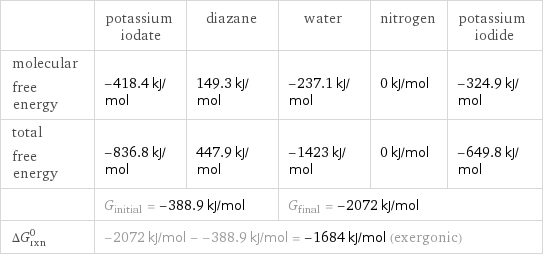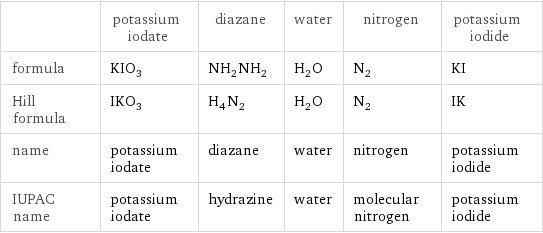Input interpretation

KIO_3 potassium iodate + NH_2NH_2 diazane ⟶ H_2O water + N_2 nitrogen + KI potassium iodide
Balanced equation

Balance the chemical equation algebraically: KIO_3 + NH_2NH_2 ⟶ H_2O + N_2 + KI Add stoichiometric coefficients, c_i, to the reactants and products: c_1 KIO_3 + c_2 NH_2NH_2 ⟶ c_3 H_2O + c_4 N_2 + c_5 KI Set the number of atoms in the reactants equal to the number of atoms in the products for I, K, O, H and N: I: | c_1 = c_5 K: | c_1 = c_5 O: | 3 c_1 = c_3 H: | 4 c_2 = 2 c_3 N: | 2 c_2 = 2 c_4 Since the coefficients are relative quantities and underdetermined, choose a coefficient to set arbitrarily. To keep the coefficients small, the arbitrary value is ordinarily one. For instance, set c_1 = 1 and solve the system of equations for the remaining coefficients: c_1 = 1 c_2 = 3/2 c_3 = 3 c_4 = 3/2 c_5 = 1 Multiply by the least common denominator, 2, to eliminate fractional coefficients: c_1 = 2 c_2 = 3 c_3 = 6 c_4 = 3 c_5 = 2 Substitute the coefficients into the chemical reaction to obtain the balanced equation: Answer: | | 2 KIO_3 + 3 NH_2NH_2 ⟶ 6 H_2O + 3 N_2 + 2 KI
Structures

+ ⟶ + +
Names

potassium iodate + diazane ⟶ water + nitrogen + potassium iodide
Reaction thermodynamics
Enthalpy

| potassium iodate | diazane | water | nitrogen | potassium iodide molecular enthalpy | -501.4 kJ/mol | 50.6 kJ/mol | -285.8 kJ/mol | 0 kJ/mol | -327.9 kJ/mol total enthalpy | -1003 kJ/mol | 151.8 kJ/mol | -1715 kJ/mol | 0 kJ/mol | -655.8 kJ/mol | H_initial = -851 kJ/mol | | H_final = -2371 kJ/mol | | ΔH_rxn^0 | -2371 kJ/mol - -851 kJ/mol = -1520 kJ/mol (exothermic) | | | |
Gibbs free energy

| potassium iodate | diazane | water | nitrogen | potassium iodide molecular free energy | -418.4 kJ/mol | 149.3 kJ/mol | -237.1 kJ/mol | 0 kJ/mol | -324.9 kJ/mol total free energy | -836.8 kJ/mol | 447.9 kJ/mol | -1423 kJ/mol | 0 kJ/mol | -649.8 kJ/mol | G_initial = -388.9 kJ/mol | | G_final = -2072 kJ/mol | | ΔG_rxn^0 | -2072 kJ/mol - -388.9 kJ/mol = -1684 kJ/mol (exergonic) | | | |
Equilibrium constant
![Construct the equilibrium constant, K, expression for: KIO_3 + NH_2NH_2 ⟶ H_2O + N_2 + KI Plan: • Balance the chemical equation. • Determine the stoichiometric numbers. • Assemble the activity expression for each chemical species. • Use the activity expressions to build the equilibrium constant expression. Write the balanced chemical equation: 2 KIO_3 + 3 NH_2NH_2 ⟶ 6 H_2O + 3 N_2 + 2 KI Assign stoichiometric numbers, ν_i, using the stoichiometric coefficients, c_i, from the balanced chemical equation in the following manner: ν_i = -c_i for reactants and ν_i = c_i for products: chemical species | c_i | ν_i KIO_3 | 2 | -2 NH_2NH_2 | 3 | -3 H_2O | 6 | 6 N_2 | 3 | 3 KI | 2 | 2 Assemble the activity expressions accounting for the state of matter and ν_i: chemical species | c_i | ν_i | activity expression KIO_3 | 2 | -2 | ([KIO3])^(-2) NH_2NH_2 | 3 | -3 | ([NH2NH2])^(-3) H_2O | 6 | 6 | ([H2O])^6 N_2 | 3 | 3 | ([N2])^3 KI | 2 | 2 | ([KI])^2 The equilibrium constant symbol in the concentration basis is: K_c Mulitply the activity expressions to arrive at the K_c expression: Answer: | | K_c = ([KIO3])^(-2) ([NH2NH2])^(-3) ([H2O])^6 ([N2])^3 ([KI])^2 = (([H2O])^6 ([N2])^3 ([KI])^2)/(([KIO3])^2 ([NH2NH2])^3)](../image_source/67f0bb38b347023af3ff183a82b95740.png)
Construct the equilibrium constant, K, expression for: KIO_3 + NH_2NH_2 ⟶ H_2O + N_2 + KI Plan: • Balance the chemical equation. • Determine the stoichiometric numbers. • Assemble the activity expression for each chemical species. • Use the activity expressions to build the equilibrium constant expression. Write the balanced chemical equation: 2 KIO_3 + 3 NH_2NH_2 ⟶ 6 H_2O + 3 N_2 + 2 KI Assign stoichiometric numbers, ν_i, using the stoichiometric coefficients, c_i, from the balanced chemical equation in the following manner: ν_i = -c_i for reactants and ν_i = c_i for products: chemical species | c_i | ν_i KIO_3 | 2 | -2 NH_2NH_2 | 3 | -3 H_2O | 6 | 6 N_2 | 3 | 3 KI | 2 | 2 Assemble the activity expressions accounting for the state of matter and ν_i: chemical species | c_i | ν_i | activity expression KIO_3 | 2 | -2 | ([KIO3])^(-2) NH_2NH_2 | 3 | -3 | ([NH2NH2])^(-3) H_2O | 6 | 6 | ([H2O])^6 N_2 | 3 | 3 | ([N2])^3 KI | 2 | 2 | ([KI])^2 The equilibrium constant symbol in the concentration basis is: K_c Mulitply the activity expressions to arrive at the K_c expression: Answer: | | K_c = ([KIO3])^(-2) ([NH2NH2])^(-3) ([H2O])^6 ([N2])^3 ([KI])^2 = (([H2O])^6 ([N2])^3 ([KI])^2)/(([KIO3])^2 ([NH2NH2])^3)
Rate of reaction
![Construct the rate of reaction expression for: KIO_3 + NH_2NH_2 ⟶ H_2O + N_2 + KI Plan: • Balance the chemical equation. • Determine the stoichiometric numbers. • Assemble the rate term for each chemical species. • Write the rate of reaction expression. Write the balanced chemical equation: 2 KIO_3 + 3 NH_2NH_2 ⟶ 6 H_2O + 3 N_2 + 2 KI Assign stoichiometric numbers, ν_i, using the stoichiometric coefficients, c_i, from the balanced chemical equation in the following manner: ν_i = -c_i for reactants and ν_i = c_i for products: chemical species | c_i | ν_i KIO_3 | 2 | -2 NH_2NH_2 | 3 | -3 H_2O | 6 | 6 N_2 | 3 | 3 KI | 2 | 2 The rate term for each chemical species, B_i, is 1/ν_i(Δ[B_i])/(Δt) where [B_i] is the amount concentration and t is time: chemical species | c_i | ν_i | rate term KIO_3 | 2 | -2 | -1/2 (Δ[KIO3])/(Δt) NH_2NH_2 | 3 | -3 | -1/3 (Δ[NH2NH2])/(Δt) H_2O | 6 | 6 | 1/6 (Δ[H2O])/(Δt) N_2 | 3 | 3 | 1/3 (Δ[N2])/(Δt) KI | 2 | 2 | 1/2 (Δ[KI])/(Δt) (for infinitesimal rate of change, replace Δ with d) Set the rate terms equal to each other to arrive at the rate expression: Answer: | | rate = -1/2 (Δ[KIO3])/(Δt) = -1/3 (Δ[NH2NH2])/(Δt) = 1/6 (Δ[H2O])/(Δt) = 1/3 (Δ[N2])/(Δt) = 1/2 (Δ[KI])/(Δt) (assuming constant volume and no accumulation of intermediates or side products)](../image_source/5fe053f61525ee40b730731e336b6965.png)
Construct the rate of reaction expression for: KIO_3 + NH_2NH_2 ⟶ H_2O + N_2 + KI Plan: • Balance the chemical equation. • Determine the stoichiometric numbers. • Assemble the rate term for each chemical species. • Write the rate of reaction expression. Write the balanced chemical equation: 2 KIO_3 + 3 NH_2NH_2 ⟶ 6 H_2O + 3 N_2 + 2 KI Assign stoichiometric numbers, ν_i, using the stoichiometric coefficients, c_i, from the balanced chemical equation in the following manner: ν_i = -c_i for reactants and ν_i = c_i for products: chemical species | c_i | ν_i KIO_3 | 2 | -2 NH_2NH_2 | 3 | -3 H_2O | 6 | 6 N_2 | 3 | 3 KI | 2 | 2 The rate term for each chemical species, B_i, is 1/ν_i(Δ[B_i])/(Δt) where [B_i] is the amount concentration and t is time: chemical species | c_i | ν_i | rate term KIO_3 | 2 | -2 | -1/2 (Δ[KIO3])/(Δt) NH_2NH_2 | 3 | -3 | -1/3 (Δ[NH2NH2])/(Δt) H_2O | 6 | 6 | 1/6 (Δ[H2O])/(Δt) N_2 | 3 | 3 | 1/3 (Δ[N2])/(Δt) KI | 2 | 2 | 1/2 (Δ[KI])/(Δt) (for infinitesimal rate of change, replace Δ with d) Set the rate terms equal to each other to arrive at the rate expression: Answer: | | rate = -1/2 (Δ[KIO3])/(Δt) = -1/3 (Δ[NH2NH2])/(Δt) = 1/6 (Δ[H2O])/(Δt) = 1/3 (Δ[N2])/(Δt) = 1/2 (Δ[KI])/(Δt) (assuming constant volume and no accumulation of intermediates or side products)
Chemical names and formulas

| potassium iodate | diazane | water | nitrogen | potassium iodide formula | KIO_3 | NH_2NH_2 | H_2O | N_2 | KI Hill formula | IKO_3 | H_4N_2 | H_2O | N_2 | IK name | potassium iodate | diazane | water | nitrogen | potassium iodide IUPAC name | potassium iodate | hydrazine | water | molecular nitrogen | potassium iodide